Explore the latest news and find out what's on this month
Explore our learning offer for schools, families and community groups
Uncover the rich history of Elmbridge with our latest online exhibitions
Want to discover more about your local area?
Explore the latest news and find out what's on this month
Explore our learning offer for schools, families and community groups
Uncover the rich history of Elmbridge with our latest online exhibitions
Want to discover more about your local area?
The Royal British Legion (RBL) was founded in May 1921, to provide support for war veterans and remember the fallen in the wake of the devastating First World War. Ensuing decades brought further conflict, during which time the Legion continued to grow. Local RBL groups raised not only thousands for the cause, but also vital awareness for the struggles of many ex-service personnel.
Back in March 2021, as schools approached the end of a long winter spent learning from home, plans for this new exhibition began. The centenary year of the RBL and Poppy Appeal was well underway, and here at Elmbridge Museum, we wanted to mark this with a special collaborative exhibition which would allow participating students to interpret real historic items. It was with this idea in mind that our Exhibitions & Interpretation Officer began talks with the History department at Hinchley Wood Secondary School, just a short walk from where the exhibition would launch at Dittons Library.
Using a work pack which included information on primary sources and original local artifacts in the collection, Years 8 and 9 at Hinchley Wood School have produced an array of stunning creative pieces, all of which reflect on what remembrance means to them. Their work is both imaginative and thought-provoking, highlighting the extremely personal significance the Poppy holds for each individual while also commemorating our shared past.
The work was originally on display from August 2021 – January 2022 alongside historic items at Dittons Library. All of the brilliant pieces featured can now be explored in this online exhibition.
In this video, discover hidden treasures from the archive which reveal the thoughts and experiences of those who lived through the First World War of 1914-18, including a message to troops, postcards and letters sent from the front lines and an appeal to raise money for the injured. All of these items contribute towards our understanding of the reasons for Remembrance Day.
Click the play button to play the video.
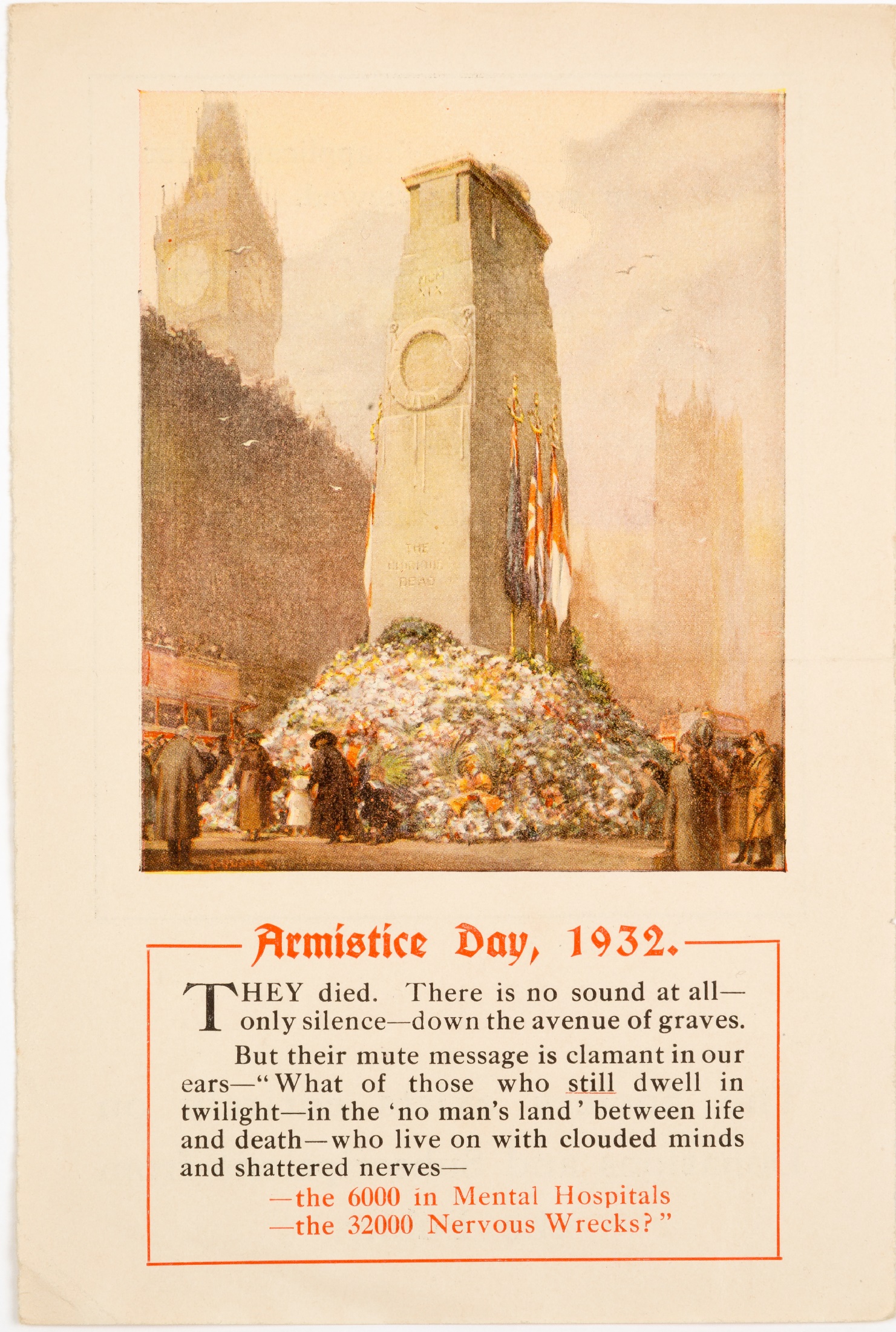 Appeal Notice with a coloured drawing of the Cenotaph, entitled 'Armistice Day, 1932'. The notice helps to demonstrate the impact of the First World War, both on those killed and those left behind to deal with physical injury and trauma.
Appeal Notice with a coloured drawing of the Cenotaph, entitled 'Armistice Day, 1932'. The notice helps to demonstrate the impact of the First World War, both on those killed and those left behind to deal with physical injury and trauma.
At 11am on the 11th November 1919, King George V, the grandfather of the present Queen, observed a two minute silence at Buckingham Palace in London. This ceremony marked the first official ‘Armistice Day’, named as such because it fell exactly a year after the guns had fallen silent across the battlefields of Europe and the armistice to mark the end of the First World War had come into effect.
The First World War was the first mechanised total war the world had ever experienced. The improved capabilities of modern weapons and large armies enabled the killing and maiming of troops on an industrial level, and it is for this reason that the First World War has taken its place in history as ‘The War to End All Wars’. Nowhere is the brutal and bleak experience of those in the front line trenches explored in grittier detail than in Peter Jackson’s 2018 film ‘They Shall Not Grow Old’, which commemorated the centenary of the war’s end.
The 20 million dead and 21 million injured in this bloody conflict sent shockwaves across the globe and left the majority of nations, towns, villages and families reeling in shock and grief. We can see the huge physical and emotional toll of the war in memorabilia, postcards and other items from the time, many of which are demonstrated above. The first Armistice Day was a way for individuals to remember their lost loved ones, and for nations to never forget the huge sacrifices that were made.
Subsequent wars – most notably the Second World War of 1939-45 – would also have a devastating impact on civilian life and see millions more young men and women killed even closer to home on the Home Front. As the deadliest conflict in the world’s history, the Second World War saw a renewed need for remembrance of the fallen. The name of ‘Armistice Day’ on the 11th November each year was hence officially changed to ‘Remembrance Day’ to encompass all modern warfare, and it has remained as such ever since.
In this piece, Isaac has created a large red remembrance poppy backed by a collage of varied photographs from the First World War. Some of these depict troops from across the world, others are images showing the celebrations on Armistice Day itself in 1918. The collage demonstrates many of the events and people we commemorate by wearing a Poppy on Remembrance Day.
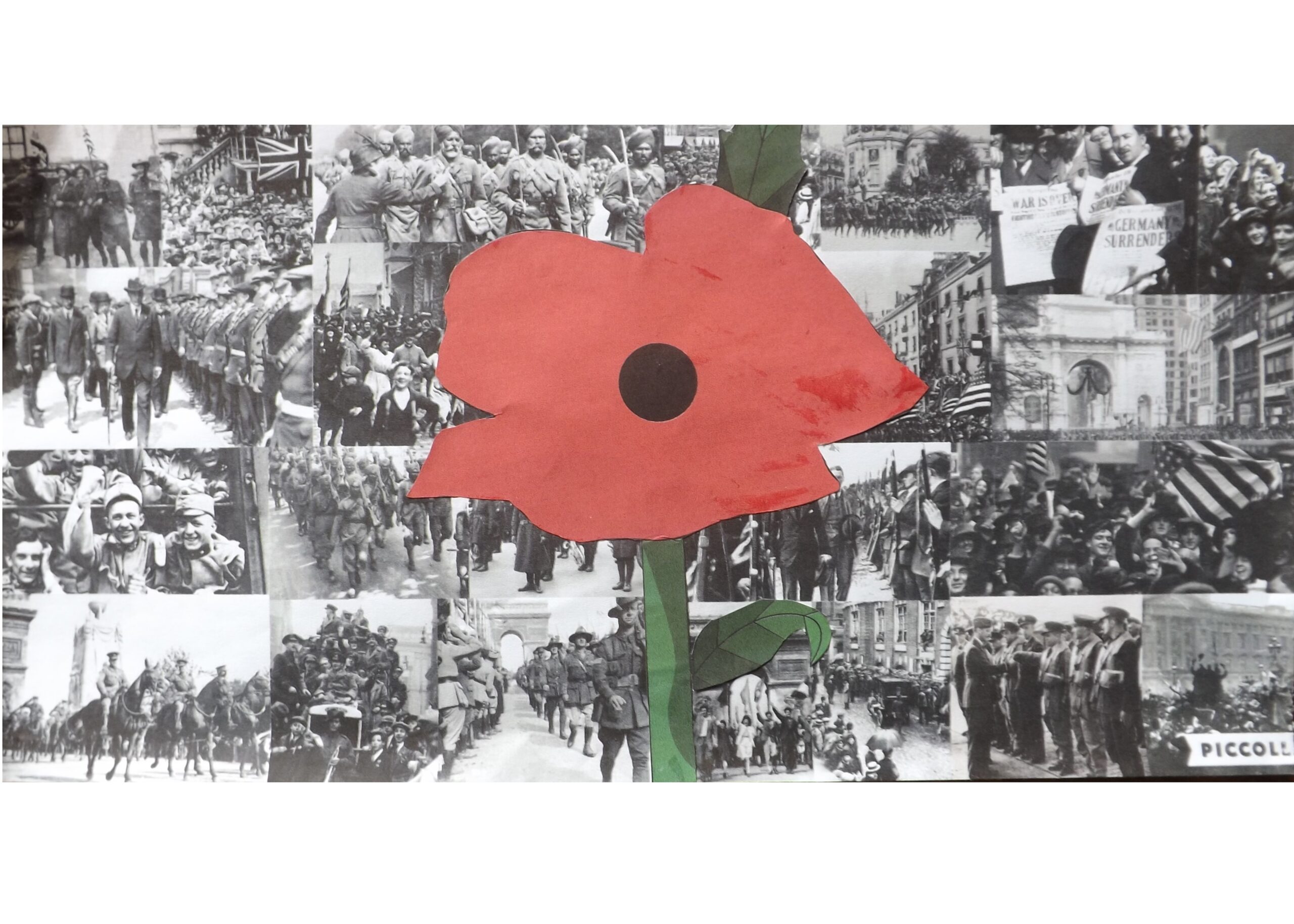
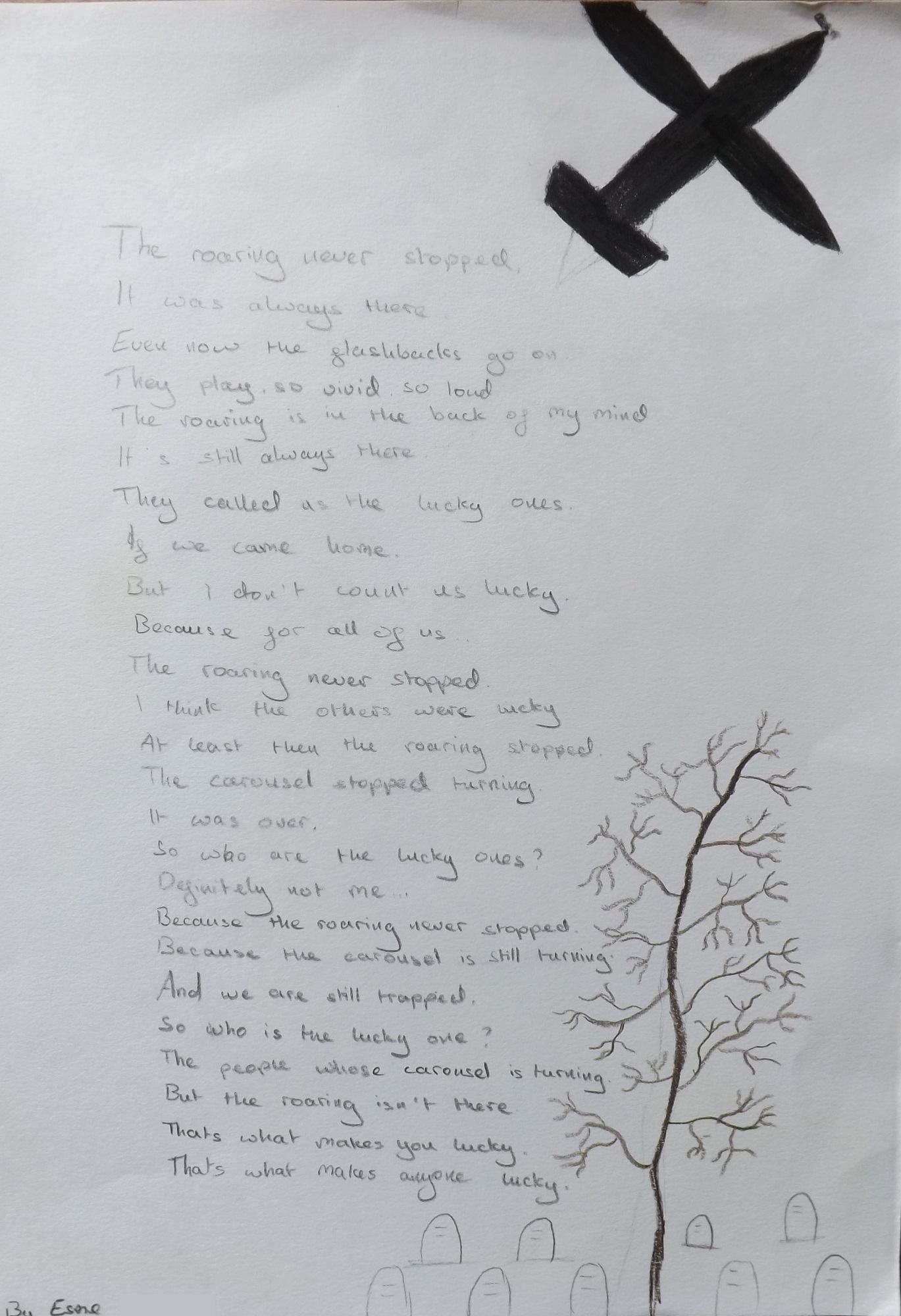
This piece by Esme takes the perspective of a soldier to make an important point about how the impact of war continues for those who survive it. As well as physical injury, many suffered emotional and mental trauma as a result of what they experienced, a ‘roaring’ that few else understood and which for some remained their entire life.
Click ‘next’ and ‘previous’ or drag the page to flick through the pages.
“The roaring never stopped.
It was always there
Even now the flashbacks go on.
They play, so vivid, so loud.
The roaring is in the back of my mind,
It’s still always there.
They called us the lucky ones
If we came home.
But I don’t count us lucky,
Because for all of us
The roaring never stopped.
I think the others were lucky,
At least then the roaring stopped.
The carousel stopped turning,
It was over.
So who are the lucky ones?
Definitely not me…
Because the roaring never stopped,
Because the carousel is still turning,
And we are still trapped.
So who is the lucky one?
The people whose carousel is turning
But the roaring isn’t there.
That’s what makes you lucky.
That’s what makes anyone lucky.’
These are the organisations which would eventually merge to form the British Legion.
Click each heading to read more about it.
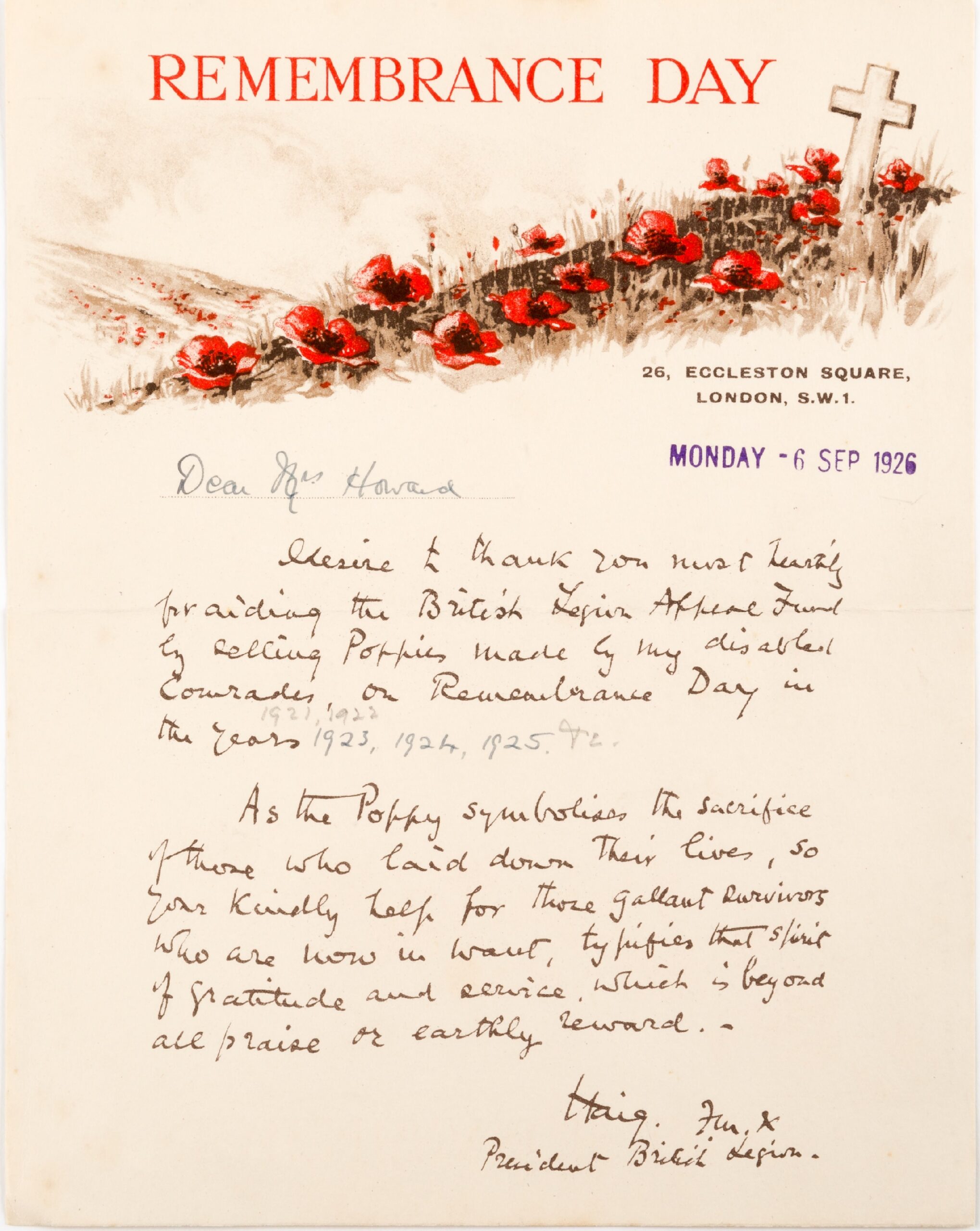 A letter from the President of the British Legion, thanking Walton local Mrs. Howard for selling poppies made by disabled veterans to raise money for the British Legion. It is dated Monday 6th September 1926, and demonstrates the continued value of the work of the British Legion which is summarised by Haig in the second paragraph.
A letter from the President of the British Legion, thanking Walton local Mrs. Howard for selling poppies made by disabled veterans to raise money for the British Legion. It is dated Monday 6th September 1926, and demonstrates the continued value of the work of the British Legion which is summarised by Haig in the second paragraph.
For most, the First World War had changed their lives irreversibly, and they struggled to get jobs and readjust to life after what they had seen in the trenches. By 1921, unemployment had reached 11.9% in the UK, the highest since records had begun. This was combined with a general lack of understanding or sympathy for people who continued to struggle – they were often deemed to be ‘malingerers’ if their mental health had not improved within a couple of years of being discharged. Resultantly, there was a desperate need for organisations to support ex-soldiers in the wake of the war and into the 1920s.
The formation of the British Legion was led by Tom Lister, from the National Federation of Discharged and Demobilized Sailors and Soldiers, and Field Marshal Earl Haig, one of the most controversial figures of the whole of the First World War. He had been commander of the British Expeditionary Force from 1915, and led the largest field army Britain had ever seen in battles including the Somme, Arras, Third Ypres, Cambrai and the ‘Hundred Days’ advances in 1918.
On the weekend of 14th and 15th May 1921, four organisations which had been set up to support veterans met at the Queen’s Hall in London. It was here that they decided to merge, together forming the ‘British Legion’. Despite each group’s gaping political differences, the Legion saw the amalgamation of all four into one clear aim: to support people who had suffered as a result of service during the First World War.
The official agreement was finally made at the Cenotaph, at the memorial to fallen soldiers.
Interested in learning more about how soldiers readjusted to 'normal' life after war? Discover our Memories of War project here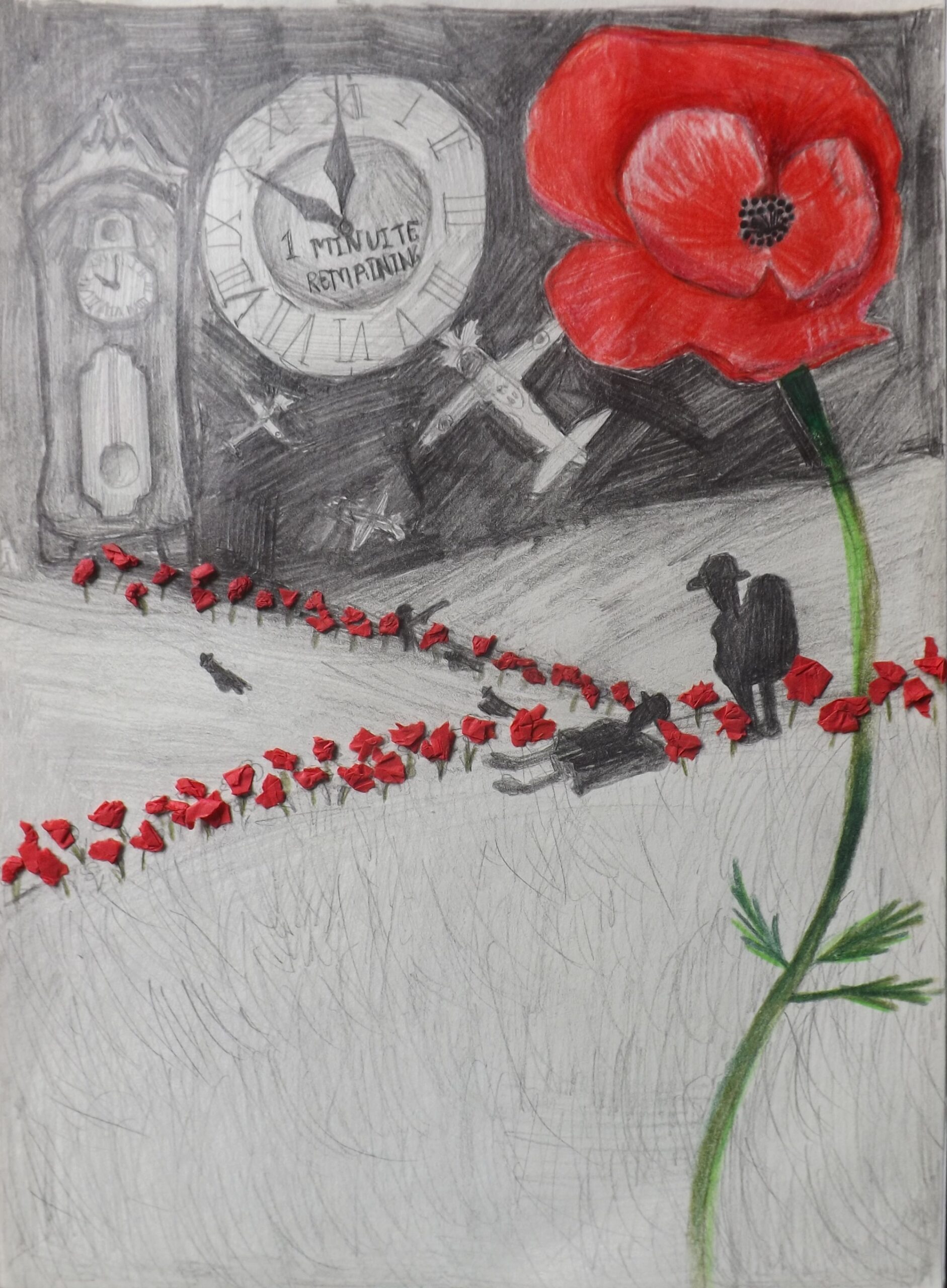
This drawing and poem by Millie highlight the importance of the two minutes’ silence on Remembrance Day. She reminds us of the modern significance of the day in remembering those involved in more recent conflicts, contrasting the peace of the silence to the deafening sounds and terrifying violence of war.
Click ‘next’ and ‘previous’ or drag the page to flick through the pages.
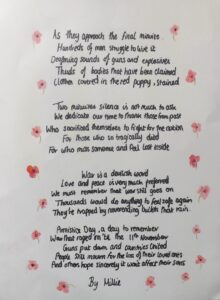
‘As they approach the final minute,
Hundreds of men struggle to live it.
Deafening sounds of guns and explosives,
Thuds of bodies that have been claimed
Clothes covered in the red poppy, stained.
Two minutes silence is not much to ask.
We dedicate our time to thank those from the past
Who sacrificed themselves to fight for the nation,
For those who so tragically died,
For who miss someone and feel lost inside.
War is a devilish word,
Love and peace is very much preferred.
We must remember that war still goes on,
Thousands would do anything to feel safe again,
They’re trapped by neverending bullets that rain.
Armistice Day, a day to remember
War that raged on ’til the 11th November,
Guns put down and countries united.
People still mourn for the loss of their loved ones,
And others hope sincerely it won’t affect their sons.’
Passage from 'Mrs Dalloway' by Virginia Woolf, 1925, in which Lucrezia struggles to understand her husband Septimus' PTSD, having been traumatised by fighting in the war.
A 1926 British Legion membership card. This belonged to prominent local British Legion member Mrs. S Howard from Walton, who raised much money for the cause over the years.
British Legion Women's Section Fixtures Booklet for the Walton and District Branch, 1937. This formerly belonged to Mrs S. Howard.
Mrs S. Howard's slip for an Annual Subscription to the British Legion Women's Section Walton Branch, for 1926.
The front of photographic shop Bedwell & Vass in Church Street, Weybridge, showing a lady standing outside the shop with a collecting tin for the British Legion's Remembrance Day.
A blank application form for the British Legion Women's Section's Walton Branch, c.1920s-30s. The rules of membership are included on the page's reverse.
Receipt for ten shillings and sixpence. Receipted to Mrs. Howard for her British Legion subscription on 11th March 1936. At this point, Mrs Howard had been a Legion member for over 10 years. Many of the historic local RBL items in our archives were donated from her own collection.
British Legion Certificate for Mr. Henry Hibbert, as a member of The Claygate Branch, January 1924. Mr Hibbert had previously been a member of the Comrades of the Great War society in the years before the Legion was formed.
Group photograph of Hersham Football Club raising money for the British Legion Poppy Appeal, 1st November 1978.
Mrs S. Howard from Walton was a longstanding member and supporter of the Royal British Legion. Indeed, the vast majority of Elmbridge Museum’s historic local Legion items come from Mrs Howard’s own personal collection, built up over her years of involvement with the Walton branch. Included amongst these items are subscription cards, booklets, letters and receipts from the ‘Women’s Section.’ Like the main British Legion, this branch had been formed in 1921, and its main focus was in supporting the widows, families, and dependents of service personnel.
Mrs Howard consistently raised the profile of the local British Legion here in Elmbridge, and as early as 1926 received a letter from the President Haig himself, thanking her for helping to sell Remembrance Day poppies. Her charitable work continued for over a decade, receiving a letter of thanks from the Secretary of the Walton branch for donating a table in 1935, and another thank-you letter in December 1937 for donating a large amount of clothing to the British Legion fund.
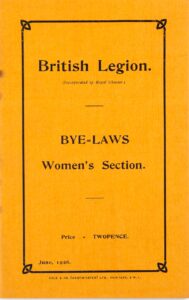
Booklet of Bye-Laws for the British Legion Women’s Section, 1926.
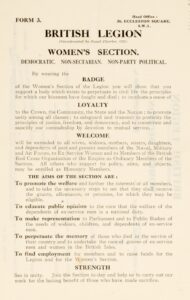
Application form with rules for the British Legion Women’s Section’s Walton branch.
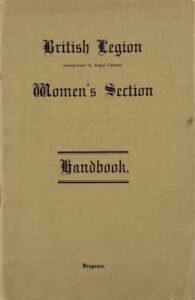
Handbook for the British Legion Women’s Section
This creative Remembrance poppy summarises the British Legion’s purpose in observing a Remembrance Day each year, bringing home the huge scale of the First World War and the numbers affected by it.
‘World War 1:
70 million soldiers, 20 million deaths, 32 countries, 1 remembrance day! 11.11’
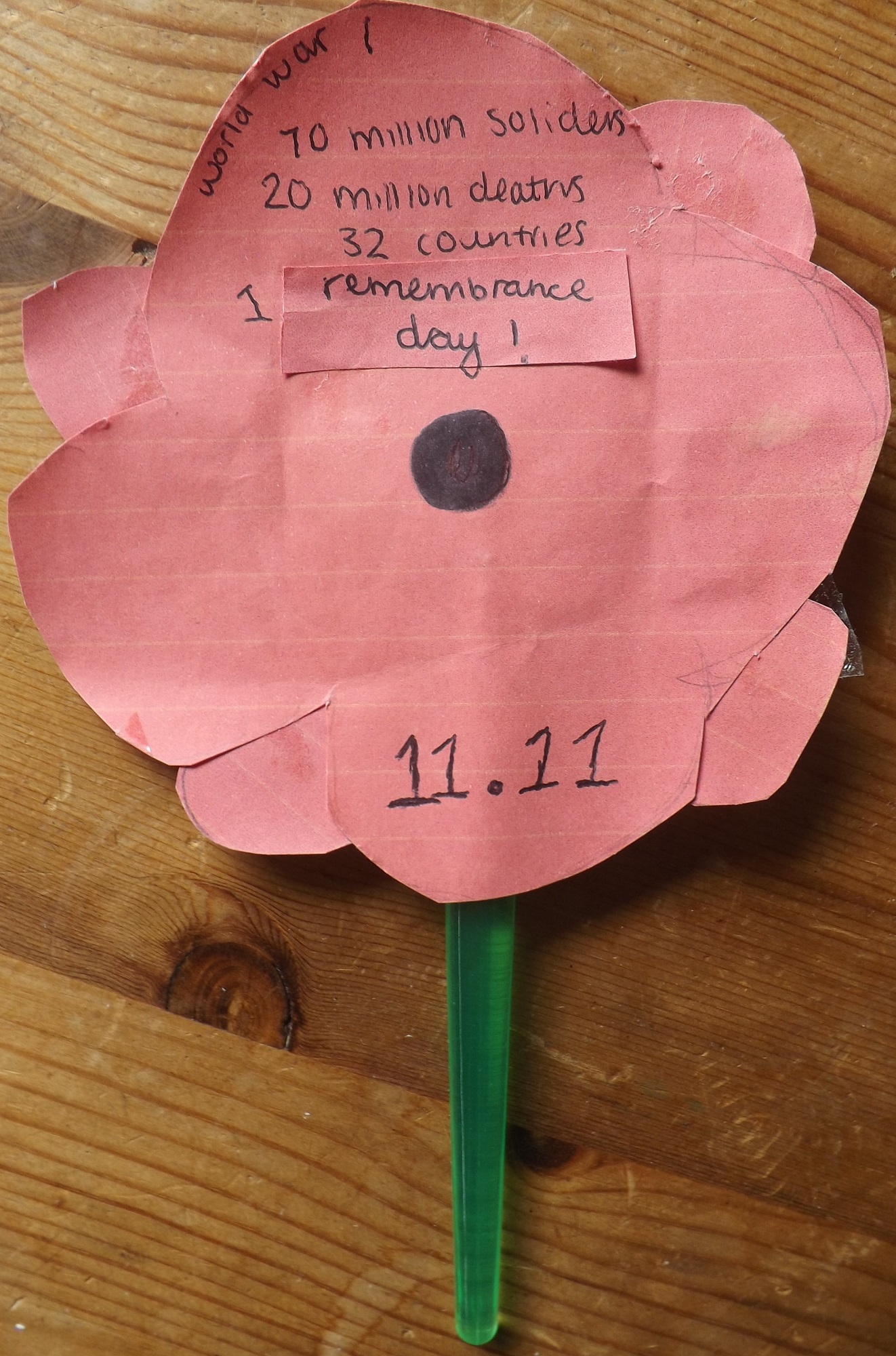
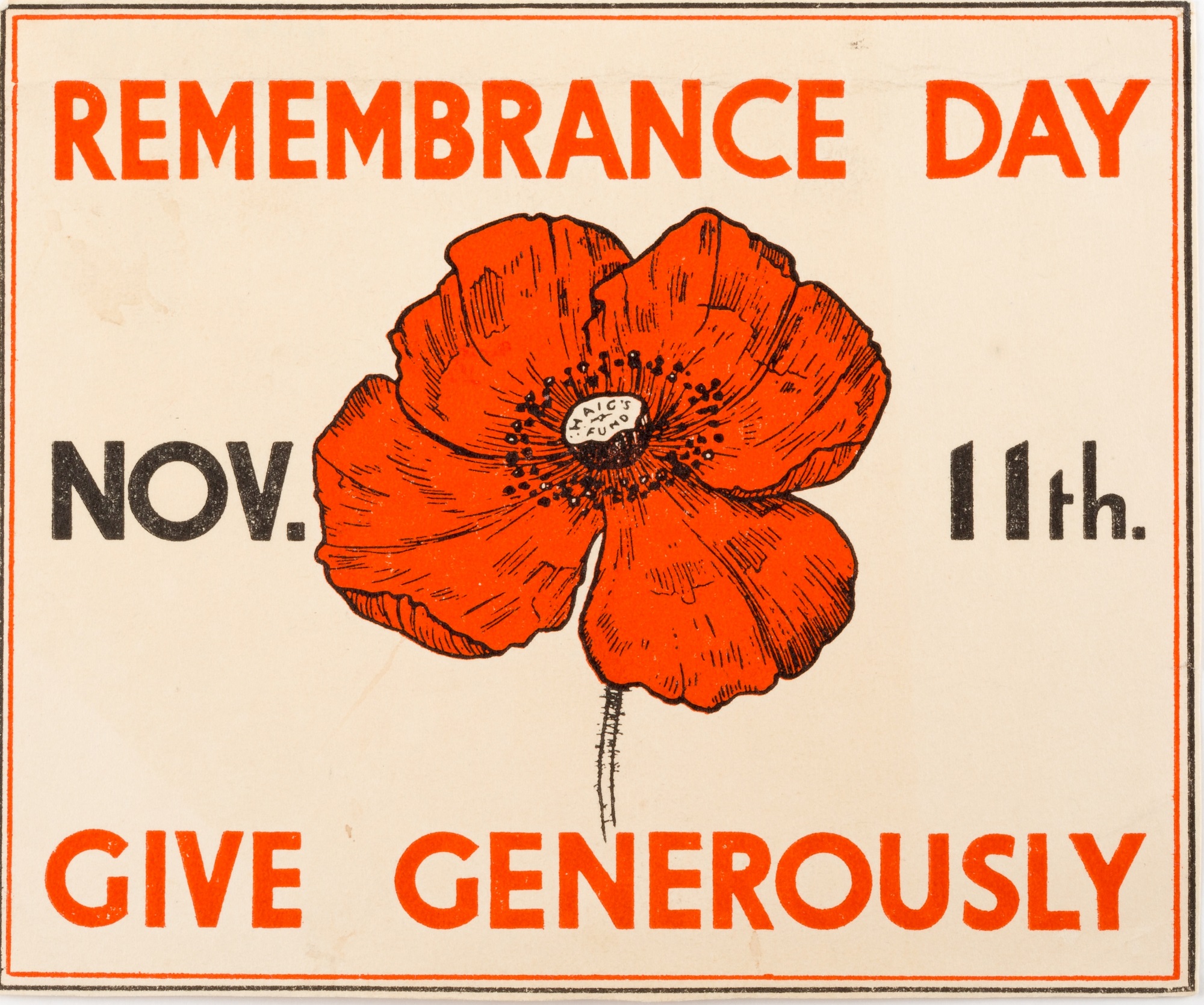 An advertisement card for Remembrance Day, saying, 'Remembrance Day, Nov. 11th, Give Generously'. This was used locally in Walton by Mrs. Howard while collecting for the Legion.
An advertisement card for Remembrance Day, saying, 'Remembrance Day, Nov. 11th, Give Generously'. This was used locally in Walton by Mrs. Howard while collecting for the Legion.
It was on ‘Armistice Day’ in the year of the British Legion’s formation, in November 1921, that the first ever Poppy Appeal was held. Every year since then, the sale of paper poppies has raised money for the Legion’s work with veterans and service personnel.
The symbol of the Poppy originated on the battlefields of Europe. The flower became a popular symbol of hope amongst the mud and death of the war through John McCrae’s famous poem ‘In Flanders Fields’. McCrae was a Lieutenant Colonel in the Canadian Armed Forces during the First World War, where he observed poppies growing every year on the battle-scarred landscape of Northern France and Belgium in spite of the devastation there.
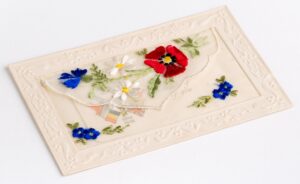
Embroidered Christmas card with a poppy on the front. Inside is a card with ‘Glorieux Souvenir 1914-15’ and ‘I’m thinking of you’ printed on it. This was sent from a soldier during the Great War, and demonstrates the prevalence of the Poppy in imagery at the time.
Anna Guerin, a former French schoolteacher, had been promoting poppies in the USA since 1920 to fundraise for war widows. In 1921 she came to Britain, and persuaded the newly formed British Legion to adopt the poppy as a symbol of remembrance for fundraising purposes, in return for organising their distribution with networks of women’s groups. She also funded the manufacture of poppies in France for the ‘Poppy Day’, with 8 million simple red fabric poppies being produced by women and children in the devastated areas of France.
The poppies sold out immediately and raised a huge £106 (roughly £5,322 in today’s money). The funds were used within the charity to help veterans with employment and housing, and the Legion has been associated with the Poppy ever since. Now, 40 million poppies are distributed each year by around 40,000 RBL volunteers.
By 1922, the poppy was not only raising money for suffering service personnel, but its very production was providing many of them with valuable work. Ex-servicemen worked at the Poppy Factory in Richmond to produce remembrance items, with the aim of aiding their own recovery and return to employment.
This drawing of two types of commemorative poppy along with a piece of historical interpretation by Athie informs us about the varied work of the Royal British Legion. It rightly points out how the Legion was concerned with all those touched by war – including the families of those affected.
‘My poppy has 2 of the original British poppies. The larger one represents the soldiers and remembering them. While my smaller poppy represents their families who also suffered, as we should remember them as well. It also shows how the British Legion helped them as it is branching from the original poppy.’
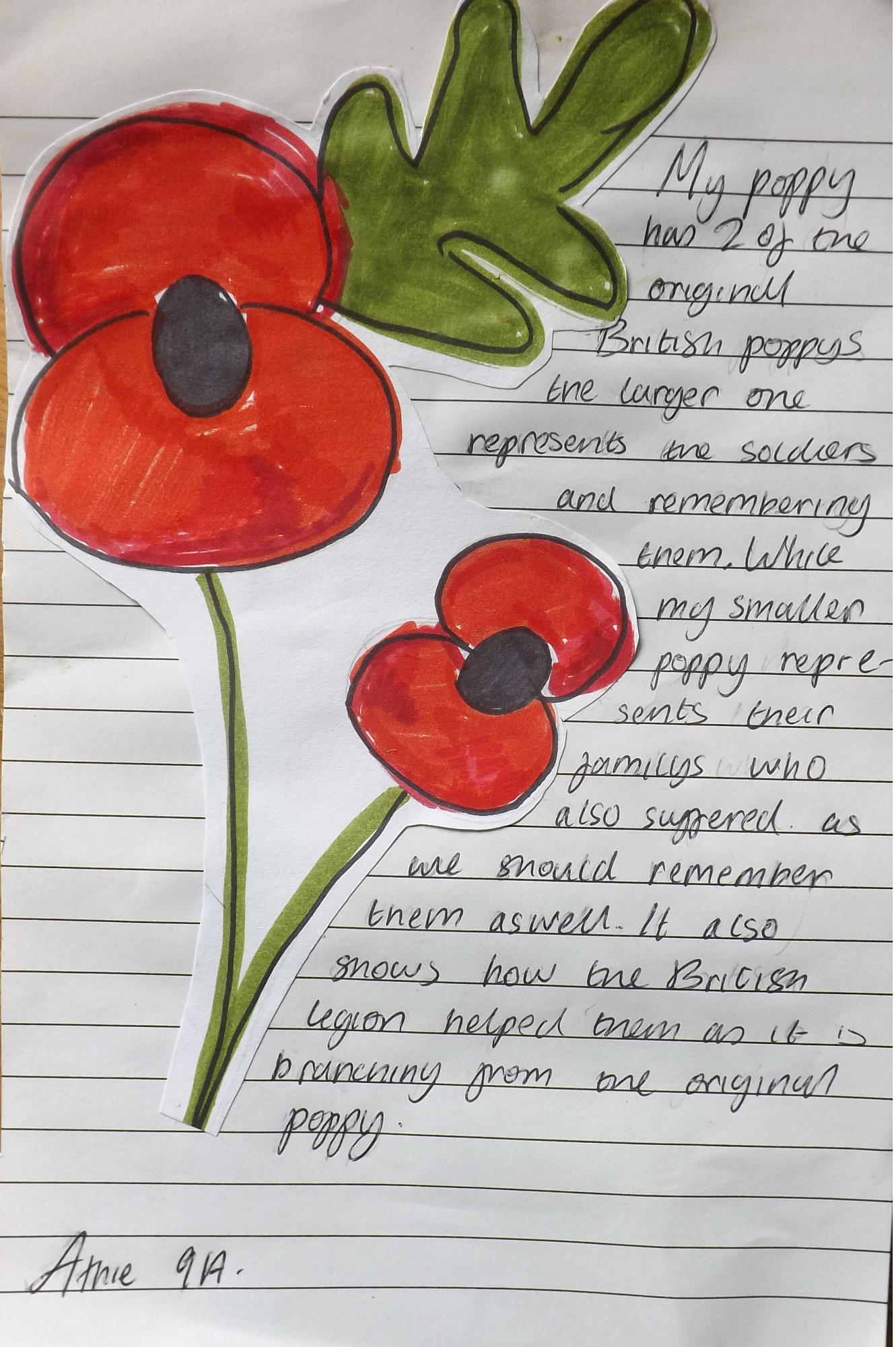
This beautiful embroidery by Indigo encapsulates the message of Remembrance Day, and depicts poppies growing in a field as they did on some battlefields of the First World War.
Click each of the tabs on the left to expand them.
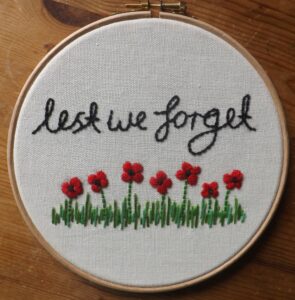
This drawing by Cassia uses the imagery of the poppy around a cross marking a war grave. It evokes the poem ‘In Flanders Fields’ by John McCrae, where he writes that “In Flanders’ fields the poppies blow / Between the crosses, row on row, / That mark our place”.
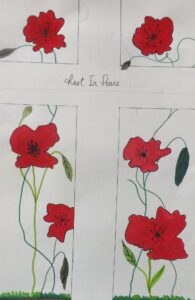
This creative piece of artwork by a student at Hinchley Wood Secondary School effectively highlights how the Poppy is a symbol of remembrance for those who lost their lives in the war. Through depicting soldiers standing in reflection, it also reminds us of the poppy’s purpose in raising money for the survivors of warfare.
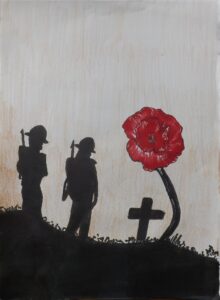
This poppy collage thoughtfully examines the purpose of Remembrance Day to remind us of the devastation caused by war. In the piece, the red of the Poppy is represented as bloodstains, with the words ‘never again’ written boldly over the top.
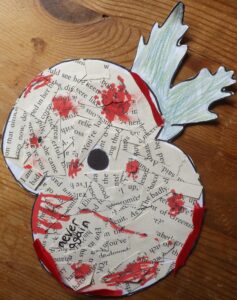
These hand-crafted poppies by students at Hinchley Wood Secondary School demonstrate the variety of ways in which people can mark Remembrance Day in their own personal ways. These poppies are creative and eye-catching, perfectly capturing the power the poppy symbol holds.

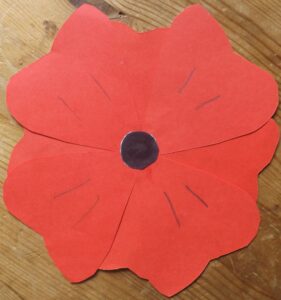
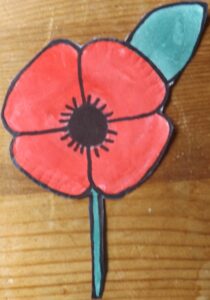
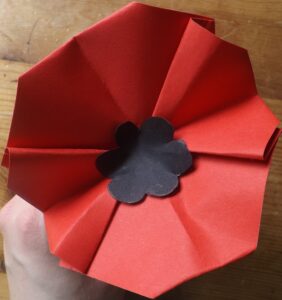 These creative paper poppies made by a student at Hinchley Wood Secondary School are accompanied by a valuable piece of museum interpretation about the background of the Poppy. They highlight the point that the sale of paper poppies not only raises money for suffering service personnel, but that the image itself acts as an important symbol loaded with historical significance.
These creative paper poppies made by a student at Hinchley Wood Secondary School are accompanied by a valuable piece of museum interpretation about the background of the Poppy. They highlight the point that the sale of paper poppies not only raises money for suffering service personnel, but that the image itself acts as an important symbol loaded with historical significance.
‘The symbol of the Poppy originates from the battlefields in Northern France and Belgium during World War One, where they grew every year despite the depression of the war. It became a symbol of hope for the soldiers, and a remembrance of those who had sadly passed. On remembrance day you might see people selling roses to raise money for war veterans with employment and housing.’
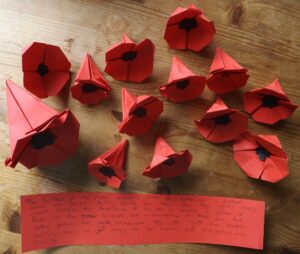
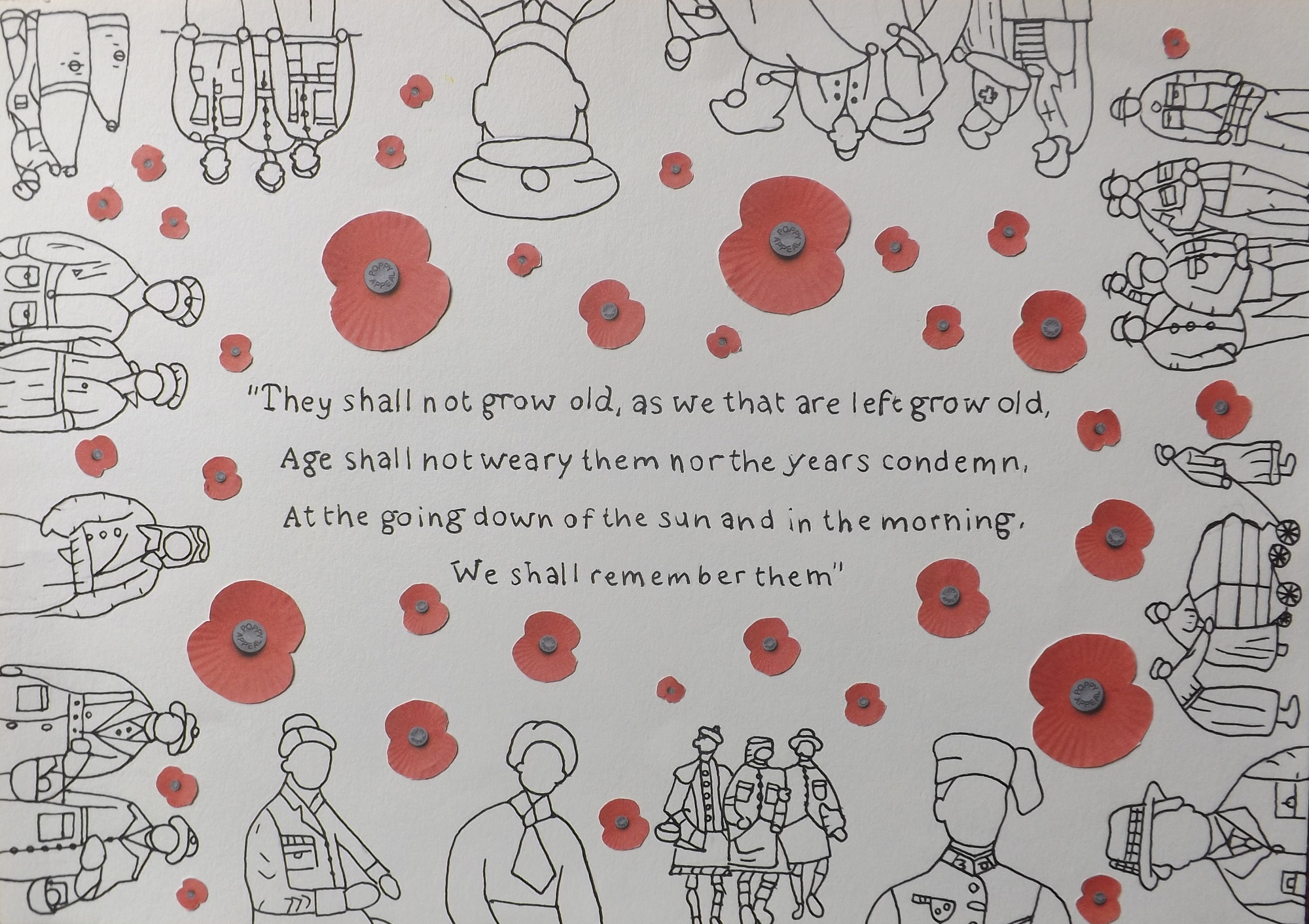
This brilliant piece by Katie uses a verse from Laurence Binyon’s popular poem ‘For the Fallen’, which was written in September 1914. Despite being published right at the beginning of the First World War, the poem – and this verse in particular – has been employed in countless Remembrance ceremonies in the decades after the conflict’s end, with attendees often speaking the last line in unison. Used in this piece, the words may evoke thoughts of services and ceremonies to remember the dead, and the images of poppies and soldiers further drive home the poem’s message that ‘we will remember them’.
‘They shall not grow old, as we that are left grow old,
Age shall not weary them nor the years condemn,
At the going down of the sun and in the morning,
We shall remember them.’
We’d love to see your thoughts on remembrance. Here, you can download the history pack used by the students at Hinchley Wood Secondary School, and contribute your own creative piece. There are lots of ideas included in the pack to get you thinking.
Simply email your work to us at ebcmuseum@elmbridge.gov.uk, or submit it in the comments section below.
Why not continue the Remembrance story by learning about the Second World War in our 'Elmbridge at War' online exhibition? It includes fascinating oral history recordings from past and present Elmbridge residents, talking about their experiences of the conflict and its lasting impact on their lives.
Visit the Elmbridge at War online exhibition
Leave a Comment
Add your thoughts here, or upload your own creative contribution to 100 Years of Remembrance!You need to be logged in to comment.
Go to login / register